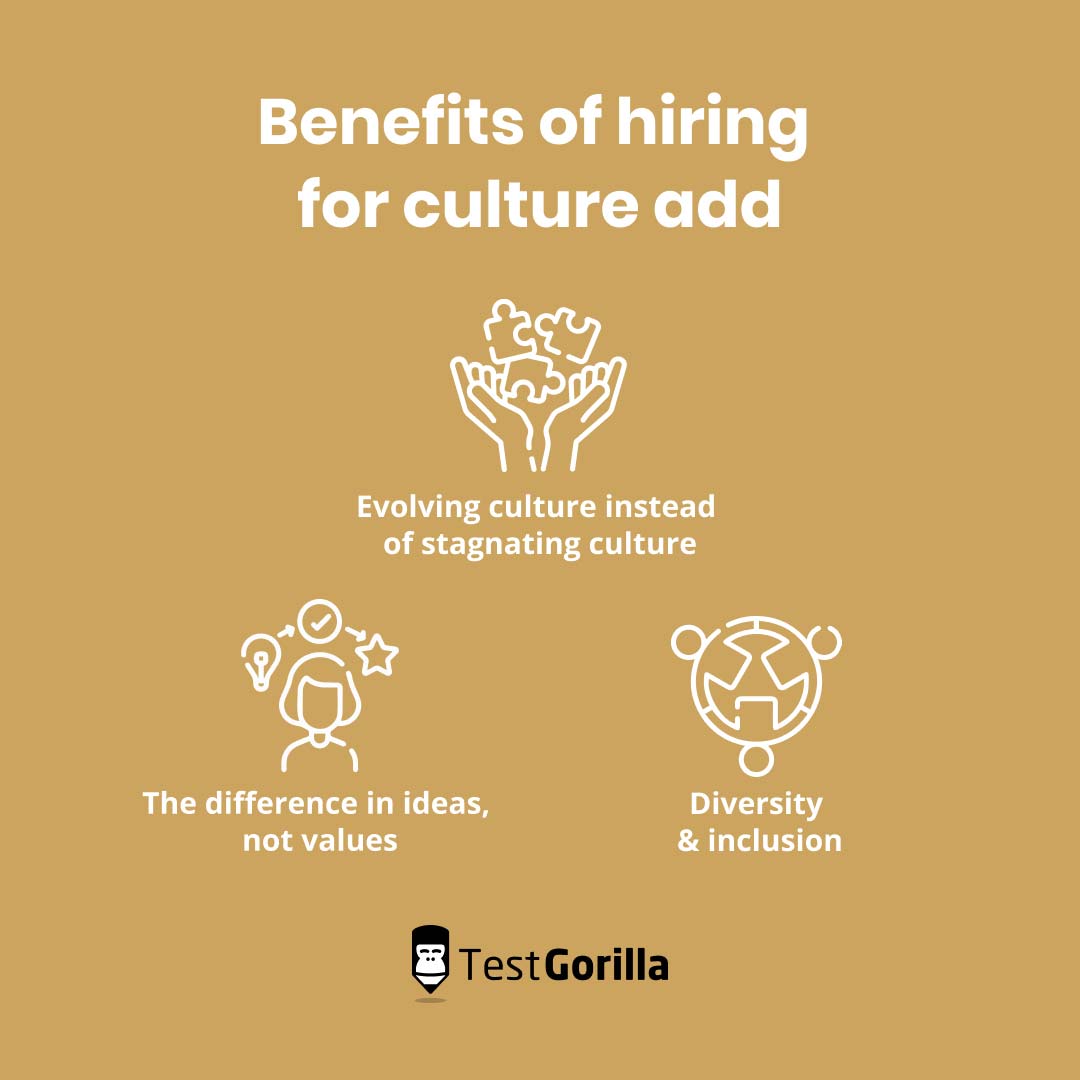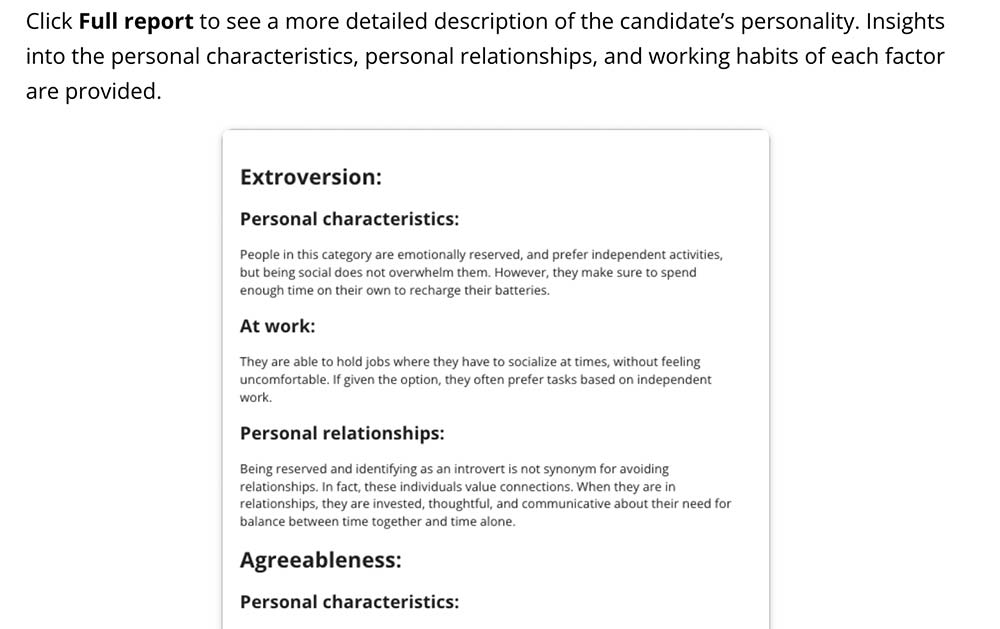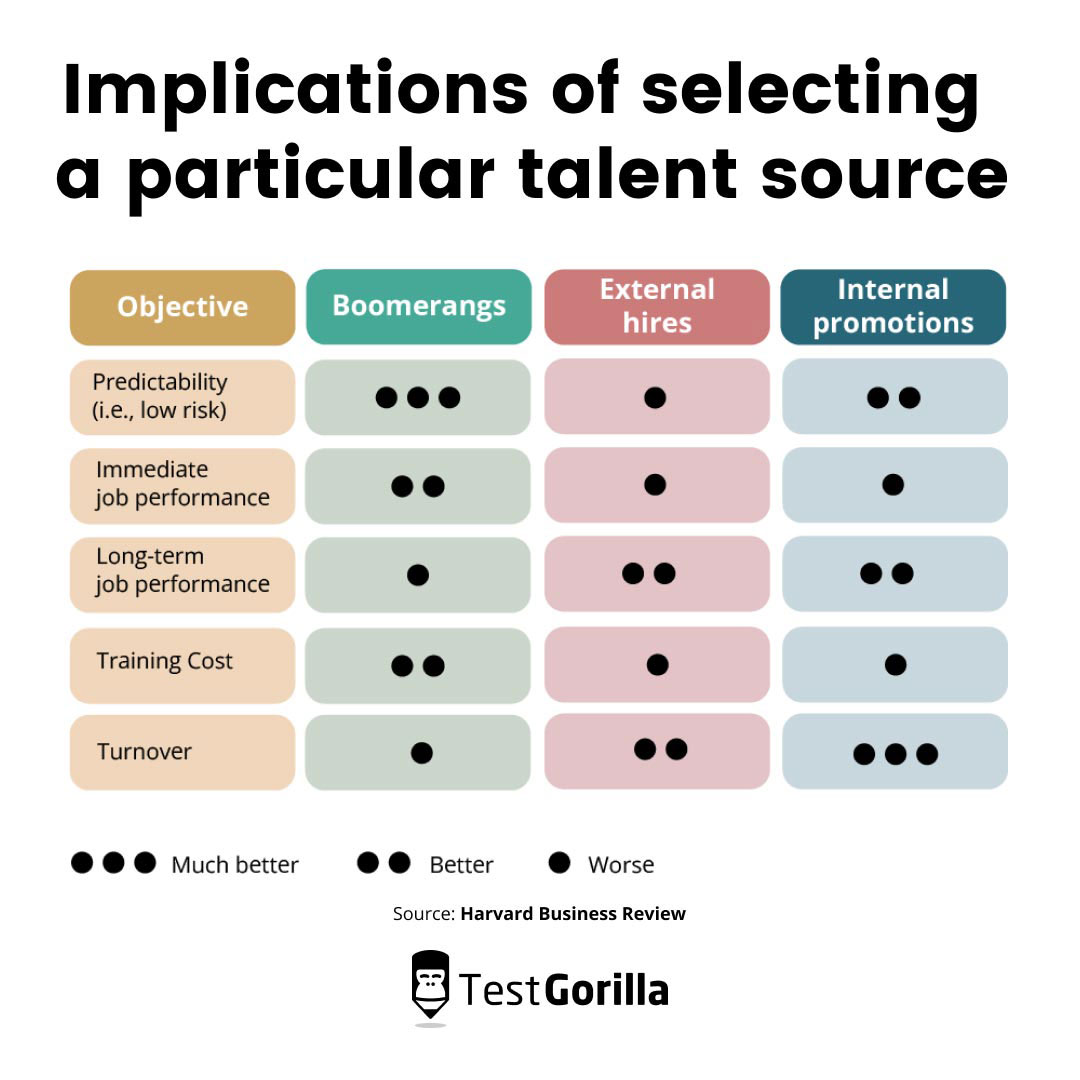Rehiring former employees: How talent assessments help unbiased decision-making
The global workforce is becoming more mobile each year, with increasing numbers of workers pursuing nonlinear careers.
Where employees once climbed the career ladder out of one workplace and into another without looking back, they are now free to choose their own path.
One of the most talked-about talent acquisition trends to arise from this is the increase in companies rehiring former employees, sometimes known as “boomerang employees.”
Examples include:
A junior employee returning in a management role after gaining more leadership skills
A manager returning as an executive after founding their own business
Rehiring laid-off employees once your business recovers
But is it always a good idea to rehire an ex-employee?
In this blog, we weigh the advantages and disadvantages of hiring former employees who had previously quit. We also offer strategies to assess whether it’s right for you to rehire a former employee in the first place.
Table of contents
- What are the benefits of rehiring former employees?
- The difficulties with rehiring former employees
- How talent assessments help with rehiring a former employee
- 7 ways to use talent assessments to determine if a former employee is right for the role
- Beyond talent assessments: 3 best practices to remember for rehiring former employees who quit
- Eliminate unconscious bias with skills tests when rehiring former employees
What are the benefits of rehiring former employees?
Next to employee referrals, rehiring former employees is the hiring method that gives you the most qualitative knowledge of candidates. But what are the other quantitative benefits of this practice?
They already know and have relationships in your organization. The workers most likely to return to their former employer after leaving are those with strong social ties to their former colleagues. This means they may start adding value sooner than outside hires.
They are more motivated than outsiders. Research suggests that when you rehire former employees, they are usually more satisfied with and committed to their roles than external new hires.
They bring back an updated skill set. For example, an employee who left to take up a similar role elsewhere will bring back adjacent skills they learned from working alongside different teams.
Their ramp-up periods are shorter. Because of their existing knowledge of your processes and culture, onboarding and training are faster than for new employees.
They offer valuable insight into your employee experience. An employee returning shows that you are a good place to work, which can contribute to a positive corporate identity if you use their story in your recruitment marketing. You can also use their feedback about why they left to strengthen your retention programs.
The difficulties with rehiring former employees
Rehiring former employees who quit clearly has the potential to be an effective and cost-saving talent acquisition strategy – but it’s not without its real risks.
Bias might sway your decision. Precisely because former employees already have relationships with your employees, your hiring managers may favor them over more qualified candidates and cause a mis-hire.
They’re more likely to leave than both internal and external hires. Particularly if their reasons for leaving haven’t been resolved, history is likely to repeat itself. Here are three of the most common types of returning employees according to the Society For Human Resource Management (SHRM) – and why they might leave again:[1]
Type | Why an employee leaves for the first time | Why they might leave again |
Traditional | To develop their skills elsewhere. They return after a few years in a more senior role. | They still see no development pathways in your organization. They leave when the employee wants a promotion and/or better compensation. |
Life event | Due to circumstances outside their control, for instance, caregiving responsibilities make their work schedule untenable. | Their personal reasons resurface, and you still don’t offer enough flexibility in the workplace. |
“Itch to scratch” | To “try out” a new career path or challenge. They return because it’s not the right fit. | They are simply unsure of what they want and change their mind again. |
They pose a risk to your reputation. As much benefit as rehiring previous employees can bring to your company, if they leave again, this could harm your employer brand even more.
There might be bad blood with other employees. This is particularly true if they left due to a conflict with a coworker.
They might not bring anything new to your culture. Diversity of thinking increases innovation by about 20%; the familiarity of a former employee may stifle the creativity of your teams.[2]
It could be more expensive overall. A quarter of returning employees were high performers in their previous roles; this means that organizations lose money when they leave and again when they pay to rehire them. Former employees typically command 25% higher pay when they return, with many also gaining more responsibility.
The best insights on HR and recruitment, delivered to your inbox.
Biweekly updates. No spam. Unsubscribe any time.
How talent assessments help with rehiring a former employee
The primary way that talent assessments help with rehiring former employees is by reducing unconscious bias.
As we touched on above, rehiring former employees is a minefield of bias due to their existing personal relationships in your organization.
An old manager who liked having them as a team member might be biased in their favor; an ex-colleague they once argued with might reject their application outright.
In traditional hiring, employers have no reliable way of measuring the skills of candidates objectively and ensuring that every employee is hired for what they know rather than who they know.
Talent assessments, on the other hand, test all candidates on the core skills for the role and create an automated shortlist based on objective data. This gives employers peace of mind that the final hire is the best choice for the role, regardless of their pre-existing connections.
The data supports this view. Although the bias for or against former employees is hard to measure, skills tests have been proven to be effective in reducing other types of bias, such as against women.
In traditional hiring, research shows that both male and female interviewers preferred hiring men, even when they’d received training on objective hiring.[3]
However, a study of more than 2,000 successful hires found that the number of women hired into senior roles increased by 70% when employers used skills-based hiring methods.
As well as reducing bias, the speed of this process reduces costs. This is particularly true when skills testing platforms are connected to other AI tools for talent acquisition, such as AI-powered applicant tracking systems (ATS), making it quicker and easier for HR managers to keep track of talent.
In addition to core skills, talent assessments also gauge the culture add factor: in other words, how a candidate brings something new to your team while staying true to its values. This helps promote diversity and create a good company culture without provoking unnecessary conflict.
Finally, as we’ll discuss shortly, skills tests revolutionize employee training and development by offering a means of targeting and tracking the learning experience of your employees.
This reduces the likelihood of rehired employees leaving again and is one of the many reasons that more than 90% of organizations see increased employee retention after switching to skills-based methods.
7 ways to use talent assessments to determine if a former employee is right for the role
By now, you understand the complexities that your hiring managers face when it comes to rehiring former employees and the broad ways that talent assessments can help.
Here are seven strategies for applying talent assessments to recruitment that ensure that when you rehire an ex-employee, you know it’s the right decision.
7 ways to use talent assessments when rehiring former employees: Summary table
Currently facing a choice between external applicants and rehiring a former employee?
Need answers fast? No problem – here’s a summary:
Strategy for using talent assessments when rehiring a former employee | Example actions |
1. Assess your existing employees to identify skills gaps | Test your current team’s core skills as well as essential soft skills Identify whether the former employee has the skills your team is missing |
2. Use the same assessments for former employees as for new candidates | Anonymize test results to prevent favoritism when shortlisting |
3. Test all candidates for motivation and culture add | When you rehire an ex-employee, check that their motivation aligns with the criteria of the role so that they won’t be tempted away again Prioritize culture add over a former employee’s legacy impact on your culture |
4. Assign personality tests to understand their fit for the role | When you assess your team’s core skills, include a personality test like the Big 5 (OCEAN) test If you want to rehire past employees, first check that their working style is compatible with key colleagues |
5. Use structured interviews to explore the results from skills tests | Ask all candidates – including former employees – the same questions, in the same order If you know the former employee well, preface the interview by explaining that you’re asking all candidates the same questions and why |
6. Use skills assessment results to design professional development plans | Collaborate with returning employees to ensure that the plan helps them meet their goals Make pathways to promotion clear |
7. Set targets for skill development using skills tests | Re-test rehired employees at intervals using the same skills tests from their professional development plans Proactively intervene if their development plateaus |
1. Assess your existing employees to identify skills gaps
To ensure that former employees hit all the key requirements of a new role, you first need to know what those requirements are. That means not only looking at the job description but also the skills of your existing team.
It’s never safe to assume that your team already has all the important skills it needs in equal measure – especially digital skills, which are developing all the time. Nearly 70% of HR professionals say their organizations have a skills gap.
After testing current employees in core skill areas as well as useful soft skills, you can then conduct a skills gap analysis to determine which skills they’re missing.
You can then prioritize candidates who exhibit these capabilities. When hiring managers know which internal skills gaps they need to address, this reduces the likelihood of them privileging returning employees just because they know they have done the job in the past.
2. Use the same assessments for former employees as for new candidates
When it comes time to test candidates, it is essential to test all candidates for:
The same skills
In the same format
Judged by the same criteria
For example, candidates applying for an open position as a senior project manager might be tested on business ethics and compliance, verbal reasoning, communication, and, of course, project management. All of which are available in our test library.
This ensures that you don’t just assume a former employee’s proficiency in key skill areas; you can quantify how skilled they are and compare it to other candidates.
To level the playing field even further, you can anonymize test results to be sure that your shortlist is as objective as possible.
This gives you peace of mind that rehired employees are as skilled as external and internal candidates at the point of hiring.
Remember: You should hire all employees for their potential, not just their prior experience. That includes their experience with their old job at your company. A former employee might have experience in your team but lack the potential to fill skills gaps and help it succeed.
3. Test all candidates for motivation and culture add
It can be difficult to ascertain a former worker’s motivations when returning to your organization. After all, their goals took them away from you once before, particularly if they left because they had an “itch to scratch.” How do you know they won’t do it again?
Our motivation test is a good place to start.
We developed this test based on the best available research, which shows that employees are the most motivated when they:
Believe their work is meaningful
See themselves as responsible for the outcomes of their work
Know the results of their effort
When setting up the test, we ask employers to correlate each of these states with the characteristics of the role. This helps to determine that returning employees are motivated by the role at hand and reduces the chance that they will disengage after a short period.
In addition to measuring motivation, you can also use skills testing to measure culture add (and not culture fit). This examines how former employees compare with internal and external hires when it comes to their ability to expand your company culture.
Of course, former employees may have helped shape your company culture to begin with. However, you should balance this prior impact against the benefit of bringing a culture-adding candidate on board who can help you grow your culture in the future.
4. Assign personality tests to understand their fit for the role
Another way to determine a returning candidate’s qualitative fit for the role is to use personality testing.
First, administer personality tests to your existing team during your initial round of internal assessments. Then, apply the same tests to your candidates.
This is a great way to predict how former employees would fit into your teams. It’s especially useful if the employee left due to dissatisfaction in their old team because it can show you whether their traits are compatible with their potential coworkers and help you diagnose the previous issue.
At TestGorilla, we offer a range of personality tests, including
16 types
The DISC test
Enneagram
Any of these could give you valuable insight when rehiring former employees.
Take the Big 5 (OCEAN) test. After candidates take the test, we assemble their results into a detailed report, showing you insights into their personal characteristics, relationships, and working habits. Here’s an example:
You could then compare this breakdown with key members of their team – for example, their direct manager – to determine whether they would work well with their immediate coworkers.
5. Use structured interviews to explore the results from skills tests
Skills assessments are not only useful in the shortlisting stage. They can also be used during the interview stage to fact-check candidates’ answers and guide your questions about their skills and motivations.
The best way to do this fairly is by using a structured interview technique. Unlike a traditional unstructured interview, structured interviews ask all candidates:
The same questions
In the same order
Judged by the same pre-agreed criteria
This doesn’t have to mean the interview process needs to be awkward, even when rehiring a former employee you know well. Simply explain that you’re asking the same questions of each candidate and ask them to answer as though you were a new employer.
Structured interviews reduce interviewer bias by ensuring all candidates are asked about the key requirements of the role. It also stops interviewers from wandering down memory lane with a former employee and forgetting to assess core criteria.
Giving interviewers a supportive structure and prior skills data to back up the information they glean from interviews gets results. One study by Google found that structured interviews predicted job performance with 26% accuracy, compared to just 14% for unstructured.[4]
6. Use skills assessment results to design professional development plans
As we’ve already seen, returning employees are highly likely to leave your organization, especially if the reasons for their original departure haven’t been addressed.
The number one reason people leave their jobs is a lack of learning and development opportunities, so this is a great place to start.[5]
Use the skills test data you gained when rehiring a former employee to craft a professional development plan for them when they rejoin the company.
This plan should contain a list of skills they need to target, a training timeline for each skill, plus any resources required to meet these goals.
If these development opportunities did not exist before rehiring a former employee, this strategy has a good chance of preventing their second exit. If development opportunities did exist before, using skills test data to make them more effective may still help but be less effective overall.
As well as making employees feel valued by your company, professional development plans also provide visible paths to promotion. This is essential for boosting retention, perhaps especially for returning employees who left to seek promotion elsewhere.
Research by SHRM shows that employees who are promoted within three years have a 70% chance of staying on board and those who make lateral moves have a 62% chance. For those who do not move internally, this is just 45%.
7. Set targets for skill development using skills tests
The goal of these strategies is to ensure that, if you’re rehiring former employees, you’re doing so because they’re not only the best candidates now, but they also have the best outlook over the long run.
Without these strategies, the chances of this are slim. The Harvard research cited above shows that without specific skill intervention, returning employees perform comparably to internal and external hires in their first year, but their performance drops off over time.
This is why professional development plans are so important when rehiring former employees.
The key step is to find a reliable way of tracking their improvement and noticing poor performance or if their development starts to drop off.
Talent assessment tests can help you here.
To ensure that rehired employees continue delivering in the long term, employers should track their employees’ progresses through upskilling programs by re-testing them with the same skills tests the plans were based on.
This provides clear performance indicators while also showing the efficacy of your training programs to senior leaders.
Beyond talent assessments: 3 best practices to remember for rehiring former employees who quit
If you’re facing a big push for recruitment and anticipating rehiring former employees, the strategies above give you a place to start.
However, it’s important to keep a few other best practices in mind when crafting your policy on rehiring former employees.
1. Address former employees’ reasons for leaving (and returning!) in final interviews
When you rehire an ex-employee, you need to be sure that history won’t repeat itself, and to do that you need to understand that history.
Make sure to first ask them about:
What’s changed since you last employed them and why they want to return to your organization
If they are coming back to do the same role, what their plans are for progression
If they are returning for a new job, particularly a more senior position, what new skills are they bringing to it that they did not previously have
You should also clarify their expectations about their salary and benefits, as well as your requirements for their performance.
2. Don’t skip the reboarding process
We know it’s tempting to skip through your onboarding checklist when rehiring a former employee. After all, they used to work here – they get the idea, right?
Nope. Even veteran employees need a refresh, particularly if they first arrived at your organization a few years ago. Their original orientation is likely to be outdated, and even if it isn’t, they may not remember it well.
Make sure to cover:
Security and data protection protocols, especially if you operate in regions where GDPR applies
Any changes to key personnel and processes that might have come into effect since their departure
How you define your company culture and what wellbeing initiatives are available to them
Their specific targets and how these will be tracked
3. Craft a proactive offboarding process for all employees
We know what you’re thinking. Offboarding programs help employees leave smoothly – but how do they help you when rehiring former employees?
The whole point is that you part ways on good terms, which leaves the door open for the future.
If employees don’t feel they can discuss their career options openly, you might miss key opportunities to stop them from leaving. You might also create an environment that employees don’t want to return to once they leave.
Make sure employees know they can discuss their options with their managers or mentors even if they’re considering leaving the organization. This gives you opportunities to encourage them to stay.
If employees do decide to leave, collect their feedback on why, even if you have no desire for them to return.
Research suggests that exit interviews are not only for gaining useful feedback but also for leaving a good impression on departing employees.
This feedback can be helpful when you rehire an ex-employee because it offers insight into why they left. This helps you evaluate their likelihood of staying long-term.
Eliminate unconscious bias with skills tests when rehiring former employees
Deciding whether or not to rehire an ex-employee using traditional hiring feels like a gamble. They might be a short-term hit with no long-term payoff.
Skills-based hiring methods reduce this uncertainty by giving you clear data for unbiased decision-making. Skills tests even help you manage rehired employees’ learning and development once you rehire them.
To find out more about speeding up your hiring process, read our blog about improving hiring efficiency.
To learn more about improving your relationship with your workforce, read our piece about the employee life cycle.
Or, if you’re already crafting your rehire policy for former employees, try out our Motivation and Culture Add tests to hire the best.
Sources
Maurer, Roy. (September 23, 2015). “Attitude on Rehiring Boomerang Workers Changing”. Society for Human Resource Management. Retrieved July 26, 2023. https://www.shrm.org/resourcesandtools/hr-topics/talent-acquisition/pages/rehiring-boomerang-workers.aspx
Bourke, Juliet. (January 22, 2018). “The diversity and inclusion revolution: Eight powerful truths”. Deloitte Review. Retrieved July 26, 2023. https://www2.deloitte.com/us/en/insights/deloitte-review/issue-22/diversity-and-inclusion-at-work-eight-powerful-truths.html
Agarwal, Pragya. (December 3, 2018). “Unconscious Bias: How It Affects Us More Than We Know”. Forbes. Retrieved July 26, 2023. https://www.forbes.com/sites/pragyaagarwaleurope/2018/12/03/unconscious-bias-how-it-affects-us-more-than-we-know/
Bock, Laszlo. (April 7, 2015). “Here's Google's Secret to Hiring the Best People”. WIRED. Retrieved July 26, 2023. https://www.wired.com/2015/04/hire-like-google/
“2019 Retention Report”. (2019). Work Institute. Retrieved July 26, 2023. https://info.workinstitute.com/hubfs/2019%20Retention%20Report/Work%20Institute%202019%20Retention%20Report%20final-1.pdf
You've scrolled this far
Why not try TestGorilla for free, and see what happens when you put skills first.






















